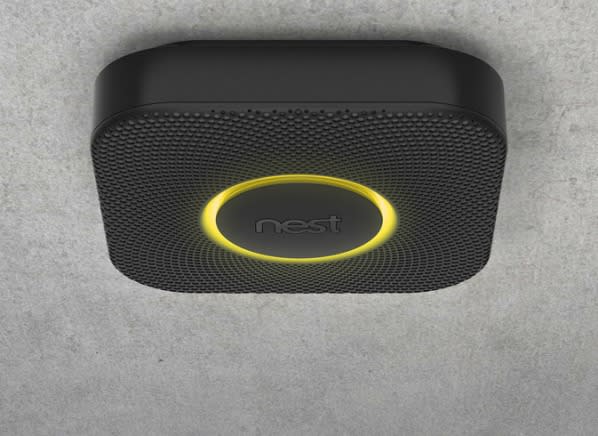Nest Protect alarm lacks dual smoke sensors

Even before Google bought its parent company for $3.2 billion dollars, the Nest Protect smoke and carbon monoxide detector was generating plenty of buzz. It "will radically change one of the most critical pieces of safety equipment in your home,” wrote Good Housekeeping. Huffington Post called the device “a smarter, more user-friendly take on a boring-but-functional appliance.” After weeks of rigorous lab testing, we’re ready to add our own review to the pile—though it doesn’t sound like all the others.
“An exercise in frustration.” That’s how one of our engineers described the process of setting up the networking functions of the Wi-Fi-enabled Nest Protect. (The alarm functions worked right out of the box.) It was reminiscent of some of the challenges we faced during testing of the Nest Learning Thermostat, the company’s flagship product, which went on sale in 2011.
With both devices, the ability to control and monitor them remotely with a smart phone or computer is a big selling point. But that setup is easier said than done, especially with the Nest Protect. Though the company’s tech support was available and knowledgeable, it was unable to help us connect a second detector to our lab’s Wi-Fi network, or to the technician’s home network. Only after another of our staff members connected two samples of the Nest Protect to his home Wi-Fi could we confirm its self-networking capabilities.
Nest falls short on some detection tests
Given our frustrations, we think that only the truly tech-savvy should attempt installing and using the Nest Protect. But even they may want to think twice. There are two types of smoke sensors on the market—photoelectric and ionization. The former is better at detecting smoky, smoldering fires, while the latter is better at detecting open flames. The Nest Protect only has a photoelectric detector, so it was not very good in our tests at detecting fast-flaming fires, like those that would result from a stack of ignited papers. And so, in order to have the fastest protection from all fires, you’d need to combine the Nest Protect with ionization smoke detectors.
Now let’s talk cost. At $130, the Nest Protect is a lot more expensive than other combo smoke and CO alarms, even those that offer wireless interconnection. Add in the fact that you should have at least one smoke detector on every level of your home and in each bedroom, and you could easily be in for $1,000, not counting additional ionization detectors.
It’s too bad that the Nest Protect has those shortcomings, because it does also offer some very helpful innovations. For example, the Nest Wave feature lets you silence nuisance alarms with the wave of a hand, rather than climbing up on a chair or reaching for the bath towel. It also has an early-alert voice warning if smoke or CO levels are rising in your home. And the Nest Protect's vocal alarms may be better than loud beeps alone at waking sleeping children. Finally, its Pathlight feature can illuminate your way when you pass under the device.
But the cons outweigh the pros, and so we are not adding Nest Protect to our recommended list of smoke alarms, although we are recommending it as a carbon monoxide alarm. Our top-rated smoke alarm is the Kidde PI9000, $23, a dual-sensor alarm that was excellent at detecting flaming and smoldering fires.
Meanwhile, we’ll continue to call on manufacturers, including the Google-enriched Nest, to come up with a single alarm that quickly detects both types of fires as well as carbon monoxide. That would really represent radical change.
—Daniel DiClerico
More from Consumer Reports:
Low cost alternatives to high end appliances
5 signs the house you want to buy is a money pit
Washer and dryer features that save loads of money
Consumer Reports has no relationship with any advertisers or sponsors on this website. Copyright © 2006-2014 Consumers Union of U.S.
